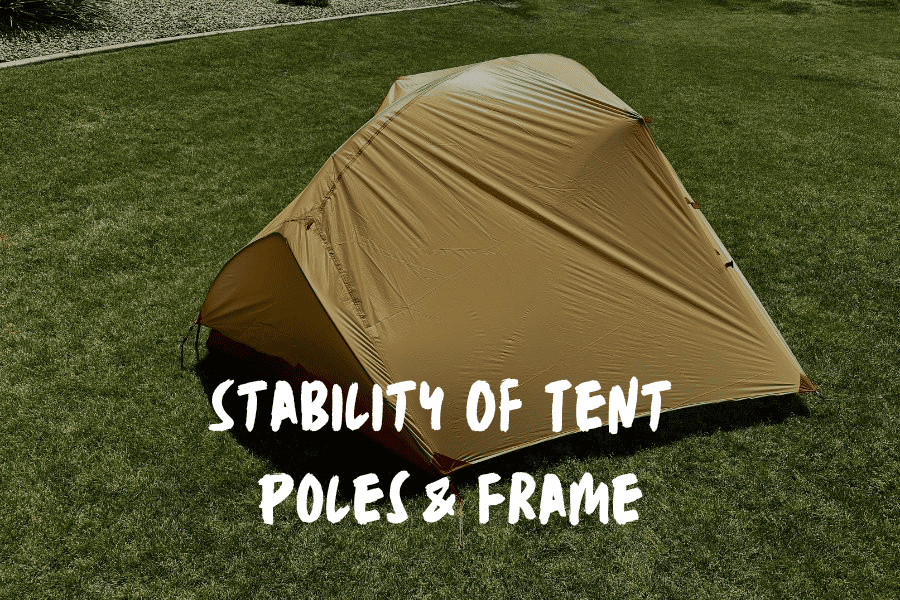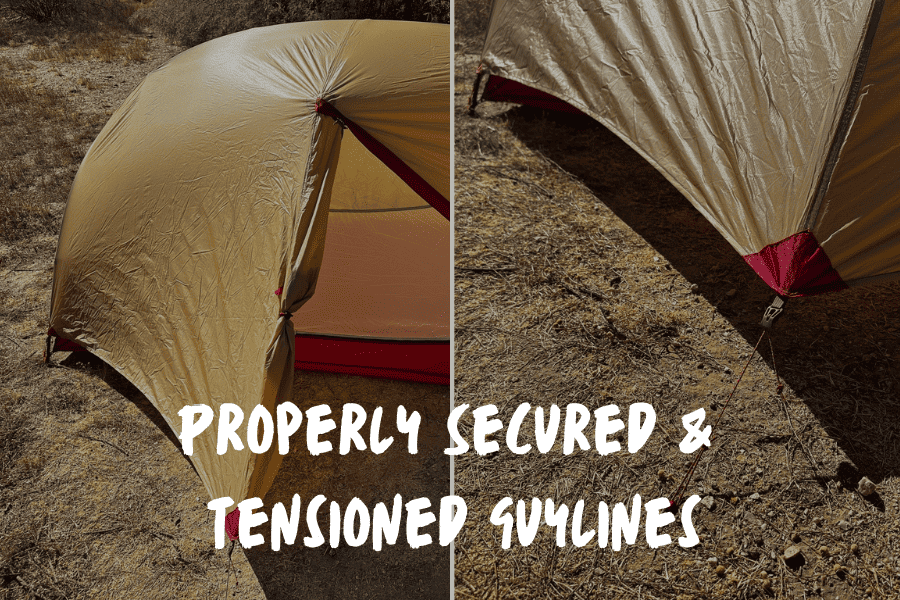Wind could make or break a tenting journey. How a lot wind your tent can stand up to is a crucial issue to consider earlier than you head out in your journey.
An excessive amount of wind can tear up your tent and break your tools – and generally, your spirit.
There are two key components to remember when serious about tents and wind resistance: dimension and form.
On the subject of wind, you’ll need to convey tents which can be decrease to the bottom and formed to divert wind, not catch it.
Some backpacking tents can stand up to as much as 45 mph winds, however most traditional tents can solely deal with as much as 20 – 30 mph.
With the precise tent, you’ll have the ability to camp even in reasonably windy circumstances.
However with out it…chances are you’ll be in for a tough tenting journey!
What wind is simply too robust for tent tenting?
Most tents can deal with average winds (20-30 mph) with some further wind resistance measures.
However as soon as winds attain sustained speeds of 30 to 40 miles per hour, it’s too robust to be tent tenting.
| Pace | 10 – 20 mph | 20 – 30 mph | 30 – 40 mph |
| Definition | Mild Breeze | Reasonable Winds | Excessive Winds |
| Tenting Security | Protected to camp | Protected to camp utilizing added wind resistance measures | Unsafe to camp |
Elements Affecting Tent Wind Resistance
Tent Measurement & Dimensions

As we talked about above, the 2 most important features to concentrate to for wind resistance are dimension and form.
First, the smaller the tent, the much less wind can have an opportunity to “get caught” on the construction.
An vital facet to remember is a tent’s peak top, or how excessive off the bottom the tallest level of your tent is.
The decrease your peak top, the nearer to the bottom you might be, and the extra steady your tent will likely be in excessive winds.
The second factor to consider is the form of the tent or its paneling.
The most wind-resistant tents have a number of panels that slope right down to the bottom (assume dome tents).
This permits them to divert wind, slightly than catch wind like a sail as lengthy, flat sides can.
Tent types that WILL typically carry out nicely in robust wind:
Tents types that may typically NOT carry out nicely in robust winds:
- Cabin Tents
- Instantaneous Tents
- Tents with Display Homes
In fact, wind efficiency will fluctuate tent by tent. So it’s not every thing, however definitely beginning off with a very good design will get you off to a very good begin.
Material Rigidity & Tautness

The very last thing you need to do is make your tent right into a sail.
That is why it’s vital to maintain the material of your tent as taut as attainable.
Material that’s pulled tight over the body of your tent is much less more likely to catch wind that may hurt your tent – or the folks inside it.
Stability Of Tent Poles & Body

When tenting in windy circumstances, you need to ensure that your tent body and poles are in good situation.
You additionally need to be certain that they join in all the precise locations.
Structural instability can result in tents bending within the wind – and even damaged poles!
On the subject of wind resistance, ultralight tents aren’t going to be the strongest rivals.
If you realize you’re headed into windy terrain, be sure to convey a tent construction that received’t blow away.
This doesn’t must imply grabbing your extra-heavy tent!
Once I’m heading into windy environments, I typically convey my 2-person, double-walled tent, and additional stakes.
Learn: How To Safe A Tent In Excessive Winds
Correctly Secured & Tensioned Guylines

As soon as your tent is all arrange, it’s completely obligatory that you just stake and tie it down to verify it’s safely and securely hooked up to the bottom.
In windy circumstances, it doesn’t matter in case your tent is often capable of arise by itself (a.okay.a. freestanding).
It nonetheless wants these stakes and guylines to maintain it on the bottom throughout large gusts of wind.
To correctly arrange your guylines, observe the instructions particular to your tent mannequin.
Particularly in case you’re in windy circumstances, be sure to’re utilizing ALL the guylines obtainable to you.
Often, this may embrace two guylines within the entrance, at the very least two within the again, and a number of on the perimeters.
The cords ought to be pulled tight. Any slack will make your tent construction weak to the wind.
When securing to the bottom, stake the guylines about two ft away from the bottom of the tent.
I like to recommend staking your guylines and masking the stakes with a heavy rock for additional safety in particularly windy circumstances.
Professional-tip: NEVER place rocks alongside the sides of the tent itself! This may solely make your tent extra more likely to rip in excessive wind circumstances.
Enhancing Tent Wind Resistance
Windy circumstances can include numerous issues.
The very last thing you need after a lengthy day of mountain climbing is a wind-induced rip in your tent throughout a storm and the ensuing soak that comes after!
Utilizing Correct Tent Set-Up & Pitching Strategies

To keep away from any wind-related calamities, it’s vital to observe your tent arrange and pitching directions to a tee.
Ensuring that your tent is about up and staked down is the primary, most vital step you possibly can soak up defending your self towards the wind.
Reinforcing Tent Construction With Extra Guylines

If the wind circumstances are particularly dicey, you possibly can add extra guylines to your preliminary set to additional safe your tent construction to the bottom.
Typically, these added guylines are positioned nearer to the highest of the tent, whereas regular guylines will likely be positioned alongside the perimeters.
Their placement is very helpful in windy terrain as a result of they create extra downward rigidity in your tent.
This may additional safe you to the bottom.
You’ll stake these guylines down the identical approach you’ll stake another.
Though, as I discussed above, I like to recommend including a rock on high of the stake to additional safe your construction.
Utilizing Windbreaks Or Pure Limitations For Wind Safety

Generally if you’re tenting, the atmosphere round you can be utilized as a pure windbreak to guard you from the wind.
So, if you’re organising camp in windy circumstances, look out for pure obstacles that may assist divert wind out of your tent.
These may be easy issues like rocks, small hills, or low-lying bushes.
It’s vital that these pure obstacles are heavy and/or secured to the bottom in order that they’ll stand as much as the wind on their very own.
You wouldn’t need your “windbreak” blowing away on a windy night time and damaging your tent – or taking you with it!
Selecting Sheltered Campsite Places For Wind-Inclined Areas

When selecting a campsite in windy circumstances, I like to recommend staying away from extremes.
You don’t need to be someplace too flat and barren, however you additionally don’t need to be someplace too closely wooded.
On flat plains, wind can hit you straight on with no barrier.
In closely wooded areas, previous bushes can lose branches to the wind, which may hit and harm your tent (and people inside it).
Due to this fact, I like to recommend discovering a campsite that has a number of pure obstacles if you camp in windy circumstances.
This fashion, you possibly can arrange your tents inside a number of windbreaks and additional defend your self and your campmates from the wind.
Should you should camp in a wooded space, keep away from organising your tent immediately underneath a tree, particularly people who look older or extra “scraggly.”
These bushes usually tend to lose limbs within the wind.
Staying Ready For Injury

Despite the fact that we’ll do every thing to forestall it, it’s finest to be ready in case wind does truly harm your tent.
Wind is simply too usually accompanied by a storm, so I all the time convey a spare tarp, some plastic baggage, and duct or climbing tape.
This helps stop me from getting soaked with incoming rain if my tent does get a rip.
Additionally See: Easy methods to Repair a Damaged Tent Pole in a Pinch (Suggestions & Methods)
FAQs
What Is Thought of Too A lot Wind For A Tent To Stand up to?
Most backpacking tents can stand up to winds as much as 35-40 mph. Kelty’s Grand Mesa can stand up to as much as 45 mph gusts.
Nevertheless, as soon as winds have reached 30-40 mph, it’s just about unsafe to camp. We don’t advocate it.
Can Wind Trigger Structural Injury To A Tent?
Sure. If the wind is simply too robust, or if the tent is just not secured correctly for top wind circumstances, structural harm can completely happen.
That is why it’s vital to observe the setup procedures on your particular tent, and observe the guidelines above for added wind resistance.
Are There Any Tent Designs Particularly Constructed To Stand up to Excessive Winds?
Whereas most tents are constructed with multi-purpose use in thoughts, there are tent designs which can be higher in windy circumstances than others.
The primary options to look out for listed here are low peak top and sloped design. Listed below are the finest tents we advocate for top winds.
How Does The Presence Of Massive Rocks Or Different Obstacles Have an effect on A Tent’s Wind Resistance?
Pure obstacles like rocks or low-lying bushes may help divert wind out of your tent and may help defend your campsite in case you arrange camp subsequent to them.
When attainable, I strongly recommend that you just arrange your tent subsequent to a pure barrier in excessive wind circumstances.
Can The Form Of A Tent Impression Its Skill To Stand up to Wind?
Sure, each the form and dimension of your tent will have an effect on its capacity to deal with excessive wind circumstances.
First, you’ll desire a tent that has a low peak top or is pretty low to the bottom. You’ll additionally desire a tent that has a number of distinctive sides.
I don’t advocate tents which have lengthy, flat sides as a result of they will catch wind like a ship sail.
As an alternative, you’ll desire a tent that has a number of, smaller panels that lightly slope to the underside of the design.
This fashion, the construction can divert wind across the tent, slightly than catch it.
Are There Any Moveable Wind-Blocking Gadgets Obtainable For Tents?
Sure and no. There are just a few moveable wind blockers available on the market, however they’re typically heavy.
This may make them troublesome to tote alongside on an extended backpacking journey.
Of their place, I like to recommend utilizing the tent pitching and securing suggestions we detailed up above.
In Abstract
Fearful concerning the wind? Questioning, “How a lot wind can a tent stand up to?” on your upcoming journey?
So long as the wind is underneath 20-30 mph, you need to have the ability to safely camp utilizing the strategies we’ve detailed above.
Completely satisfied tenting!
